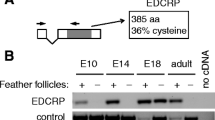Abstract
The hard keratins of mammals and birds have been extensively studied over recent years and a considerable body of knowledge is now available on the structure and composition of the constituent proteins and of their arrangement within the keratin structure1. Mammalian keratins have a very characteristic structure in which filaments of about 70A diameter are embedded in a non-filamentous matrix composed of sulfur-rich and glycine-tryosine-rich proteins. The filaments are responsible for the α-type X-ray pattern. In contrast avian keratins contain only one family of proteins arranged as small filaments of about 30A diameter which are responsible for a characteristic X-ray pattern, often referred to as the feather type. No sequence homology has been found between avian and mammalian keratin proteins and it is generally considered that they represent separate evolutionary developments.
Access this chapter
Tax calculation will be finalised at checkout
Purchases are for personal use only
Preview
Unable to display preview. Download preview PDF.
Similar content being viewed by others
References
R.D.B. Fraser and T.P. MacRae, Current views on the keratin complex, in: The Skin of Vertebrates, R.I.C. Spearman and P.A. Riley, eds., Academic Press, London (1980).
J.M. Gillespie,R.C. Marshall, and E.F. Woods, A comparison of lizard claw keratin proteins with those of avian beak and claw, J. Mol. Evol. 18: 121 (1982)
R.C. Marshall and J.M. Gillespie, The tryptophan-rich keratin protein fraction of claw of the lizard: Varanus gouldii, Comp. Biochem. Physiol. 71B: 623 (1982).
W.F. Brandt, A. Henschen, and C. von Holt, Nature and extent of peptide bond cleavage by anhydrous heptafluorobutyric acid during Edman degradation, Hoppe-Seyler’s Z. Physiol. Chem. 361: 943 (1980).
A.S. Inglis, Cleavage at aspartic acid, in: Methods in Enzymology, 91, C.H.W. Hirs and S.N. Timasheff, eds., Academic Press, New York (1983).
P. Edman, and G. Begg, A Protein sequenator, Eur. J. Biochem. 1: 80 (1967)
A.S. Inglis, P.M. Strike, W.C. Osborne and R.W. Burley, Sequenator determination of the amino acid sequence of apovitellenin I from turkey’s egg yolk, FEBS Lett. 97: 179 (1979).
M.W. Hunkapiller, R.M. Hewick, W.J. Dreyer, and L.E. Hood, High sensitivity sequencing with a gas-phase sequenator, in: Methods in Enzymology, 91, C.H.W. Hirs and S.N. Timasheff, eds., Academic Press, New York (1983).
I.J. O’Donnell, and A.S. Inglis, Amino acid sequence of a feather keratin from silver gull (Larus novae-hollandiae) and comparison with one from emu (Dromaius novae-hollandiae), Aust. J. Biol. Sci. 27: 369 (1974).
T. Haylett, and L.S. Swart, Studies on the high-sulfur proteins of reduced Merino wool, Textile Res. J., 39: 917 (1969).
J.M. Gillespie, T. Haylett, and H. Lindley, Evidence of homology in a high-sulfur protein fraction (SCMK-B2) of wool and hair α-keratins, Biochem. J. 110: 198 (1968).
W.N. Strickland, M.S. Strickland, P.C. de Groot and C. von Holt, The primary structure of histone H2A from the sperm cell of the sea urchin Parechinus angulosus, Eur. J. Biochem., 109: 151 (1980).
P.M. Steinert, A.C. Steven, and D. R. Roof, Structural features of epidermal keratin filaments reassembled in vitro, J. Invest, Dermatology 81: 86 (1983).
Author information
Authors and Affiliations
Editor information
Editors and Affiliations
Rights and permissions
Copyright information
© 1987 Plenum Press, New York
About this chapter
Cite this chapter
Inglis, A.S., Morton Gillespie, J., Roxburgh, C.M., Whittaker, L.A., Casagranda, F. (1987). Sequence of a Glycine-Rich Protein from Lizard Claw: Unusual Dilute Acid and Heptafluorobutyric Acid Cleavages. In: L’Italien, J.J. (eds) Proteins. Springer, Boston, MA. https://doi.org/10.1007/978-1-4613-1787-6_77
Download citation
DOI: https://doi.org/10.1007/978-1-4613-1787-6_77
Publisher Name: Springer, Boston, MA
Print ISBN: 978-1-4612-9001-8
Online ISBN: 978-1-4613-1787-6
eBook Packages: Springer Book Archive




